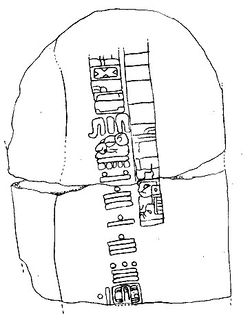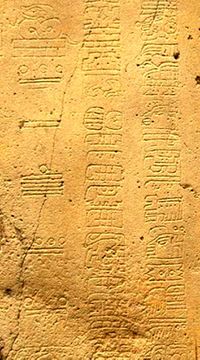تقويم العد الطويل في أمريكا الوسطى
تقويم العد الطويل في أمريكا الوسطى Mesoamerican Long Count calendar، هو تقويم غير متكرر، عشريني (يعتمد على 20)، وتقويم يعتمد على الرقم 18، استخدمته ثقافات أمريكا الوسطى ما قبل كولمبس، ومن أشهرهم شعوب المايا. لهذا السبب، يعرف في بعض الأحيان بإسم تقويم العد الطويل للمايا. باستخدام الحساب العشريني المعدل، يحدد تقويم العد الطويل أي يوم بعدّ الأيام التي مرت منذ تاريخ بدء الخليقة الأسطوري الذي يوافق 11 أغسطس 3114 ق.م. في التقويم الگريگوري.[n 1] كان تقويم العد الطويل مستخدماً بكثرة في صروح تلك الحضارة.

خلفية
فترات العد الطويل
الجدول التالي يوضح مكافئات الفترات الزمنية وأسماء المايا لتلك الفترات:
| التصوير | تقسيمات العد الطويل الفرعية | الأيام | ~ السنوات الشمسية |
|---|---|---|---|
| 0.0.0.0.1 | 1 k'in | 1 | 1/365 |
| 0.0.0.1.0 | 1 وينال = 20 k'in | 20 | 0.055 |
| 0.0.1.0.0 | 1 تون = 18 winal | 360 | 0.986 |
| 0.1.0.0.0 | 1 k'atun = 20 tun | 7,200 | 19.71 |
| 1.0.0.0.0 | 1 b'ak'tun = 20 k'atun | 144,000 | 394.3 |
ترقيمات أمريكا الوسطى
العد الطويل المبكر
| الموقع الأثري | الاسم | التاريخ الگريگوري
GMT (584283) الارتباط |
العد الطويل | الموقع |
|---|---|---|---|---|
| Chiapa de Corzo | Stela 2 | 6 ديسمبر، 36 ق.م | 7.16.3.2.13 | چياپاس، المكسيك |
| Tres Zapotes | النصب C | 1 سبتمبر، 32 ق.م | 7.16.6.16.18 | ڤراكروز، المكسيك |
| إل باول | النصب 1 | 2 مارس، 37 ق.م | 7.19.15.7.12 | گواتيمالا |
| أباخ تاكاليك | النصب 5 | 19 مايو، 103 ق.م | 8.3.2.10.15 | گواتيمالا |
| Abaj Takalik | Stela 5 | 3 يونيو 126 ق.م | 8.4.5.17.11 | گواتيمالا |
| La Mojarra | Stela 1 | 19 مايو، 143 ق.م | 8.5.3.3.5 | ڤراكروز، المكسيك |
| La Mojarra | Stela 1 | 11 يوليو، 156 ق.م | 8.5.16.9.7 | ڤراكروز، المكسيك |
| Near La Mojarra | Tuxtla Statuette | 12 مارس 162 ق.م | 8.6.2.4.17 | ڤراكروز، المكسيك |

This is the second oldest Long Count date yet discovered. The numerals 7.16.6.16.18 translate to September 1, 32 BCE (Gregorian). The glyphs surrounding the date are what is thought to be one of the few surviving examples of Epi-Olmec script.

الارتباط بين التقاويم العربية والعد الطويل
ترتبط تقاويم المايا والتقاويم الغربية باستدام رقم اليوم الجولياني لبدء تاريخ الخلق الحالي – 13.0.0.0.0 4 Ajaw, 8 Kumk'u.[n 2] ويشار إليه بالعلاقة الثابتة.
| الاسم | العلاقة |
|---|---|
| بوديتش | 394,483 |
| ويلسون | 438,906 |
| سمايلي | 482,699 |
| ماكمسون | 489,138 |
| سپيندن المعدل | 489,383 |
| سپيندن | 489,384 |
| تيپل | 492,622 |
| دينسمور | 497,879 |
| −4CR | 508,363 |
| −2CR | 546,323 |
| Stock | 556,408 |
| گودمان | 584,280 |
| مارتينز-هرناندز | 584,281 |
| توقيت گرينتش | 584,283 |
| ثمپسون المعدل 1 | 584,284 |
| ثمپسون (لونسبري) | 584,285 |
| پوگو | 588,626 |
| +2CR | 622,243 |
| بوام | 622,261 |
| كريخگاور | 626,927 |
| +4CR | 660,203 |
| فلز | 660,208 |
| هوخليتنر | 674,265 |
| شولتز | 677,723 |
| إسكالونا-راموس | 679,108 |
| ڤايلانت | 679,183 |
| ڤايتزل | 774,078 |
| تاريخ العد الطويل[n 3] | التاريخ الگريگوري GMT (584283) correlation |
|---|---|
| 13.0.0.0.0 | 11 أغسطس 3114 ق.م |
| 1.0.0.0.0 | 13 نوفمبر 2720 ق.م |
| 2.0.0.0.0 | 16 فبراير 2325 ق.م |
| 3.0.0.0.0 | 21 مايو 1931 ق.م |
| 4.0.0.0.0 | 23 أغسطس 1537 ق.م |
| 5.0.0.0.0 | 26 نوفمبر 1143 ق.م |
| 6.0.0.0.0 | 28 فبراير 748 ق.م |
| 7.0.0.0.0 | 3 يونيو 354 ق.م |
| 8.0.0.0.0 | 5 ديسمبر 41 م |
| 9.0.0.0.0 | 9 ديسمبر 435 |
| 10.0.0.0.0 | 13 مارس 830 |
| 11.0.0.0.0 | 15 يونيو 1224 |
| 12.0.0.0.0 | 18 سبتمبر 1618 |
| 13.0.0.0.0 | 21 ديسمبر 2012 |
| 14.0.0.0.0 | 26 مارس 2407 |
| 15.0.0.0.0 | 28 يونيو 2801 |
| 16.0.0.0.0 | 1 أكتوبر 3195 |
| 17.0.0.0.0 | 3 يناير 3590 |
| 18.0.0.0.0 | 7 أبريل 3984 |
| 19.0.0.0.0 | 11 يوليو 4378 |
| 1.0.0.0.0.0 | 13 أكتوبر 4772 |
نهاية تقويم المايا 2012
حسب پوپول ڤوه، وهو كتاب يجمع تفاصيل حسابات الخلق المعروفة لدى الكيتشه الماياويين في الأراضي العالية في الفترة الاستعمراية، نحن نعيش في العالم الرابع.[2] يصف الپوپول ڤوه أحداث الخلق الثلاث الاولى والتي فشل فيها الله ونجاحه في عملية الخلق الرابعة التي خُلق فيها الرجال. في تقويم العد الطويل الماياوي، انتهى العالم السابق، الثالث وبدأ العالم الحالي، الرابع في الرابع عشر من باكتون b'ak'tun.
انتهى العالم السابق في تقويم العد الطويل في 12.19.19.17.19. وسيبدأ عالم جديد 12.19.19.17.19 في 20 ديسمبر 2012، عند بداية الرابع عشر من باكتون 13.0.0.0.0, في 21 ديسمبر 2012.[n 4]
- وكالة الفضاء الأمريكية، ناسا، تفند أطروحة نهاية العالم في 21-12-2012 حسب تقويم المايا
الحساب الكامل لتاريخ العد الطويل

| 9 | × 144000 | = 1296000 |
| 12 | × 7200 | = 86400 |
| 2 | × 360 | = 720 |
| 0 | × 20 | = 0 |
| 16 | × 1 | = 16 |
| إجمالي الأيام | = 1383136 |
حساب قسم تاريخ التزولكين
ترتيبات الپيكتونات والأعلى
انظر أيضاً
مرئيات
- وكالة الفضاء الأمريكية، ناسا، تفند أطروحة نهاية العالم في 21-12-2012 حسب تقويم المايا
الهوامش
- ^ The correlation between the Long Count and Western calendars is calculated according to the one used by a majority of Maya researchers, known as the (modified) GMT or Goodman-Martinez-Thompson correlation. An alternate correlation sometimes used puts the starting date two days later. August 11, 3114 BCE is a date in the proleptic Gregorian calendar, which equates to September 6, 3114 BCE in the Julian calendar and −3113 in astronomical year numbering. انظر Correlations between Western calendars and the Long Count calendar section elsewhere in this article for details on correlations.
- ^ All extant Maya inscriptions that represent this base date wrote it with a 13 Bak'tuns, not 0, however, when using this as a base date in calculations this 13 functions mathematically as if it were a zero.
- ^ Freidel, Schele & Parker use 13 for higher order positions of piktuns and kalatuns (for example, 13.13.13.0.0.0.0) when not occupied by 1 or 0 to conform to the unlimited number of 13s larger than b'ak'tuns discussed in Piktuns and higher orders. B'ak'tuns 2–12 & 14–19 are interpolated between the authors' 13.13.1.0.0.0.0, 13.13.13.0.0.0.0 and 13.1.0.0.0.0.0.[1]
- ^ Various sources place this on other dates, notably on December 23.[3]
المصادر
المصادر
- Boot, Eric (2002). "The Dos Pilas-Tikal Wars from the Perspective of Dos Pilas Hieroglyphic Stairway 4" (PDF). Mesoweb Articles. Mesoweb. Retrieved 2007-03-15.
{{cite web}}: CS1 maint: multiple names: authors list (link) - Coe, Michael D. (1992). Breaking the Maya Code. London and New York: Thames & Hudson. ISBN 0-500-05061-9. OCLC 26605966.
{{cite book}}: CS1 maint: multiple names: authors list (link) - Coe, Michael D. (2002). Mexico: from the Olmecs to the Aztecs (5th, revised and enlarged ed.). London and New York: Thames & Hudson. ISBN 0-500-28346-X. OCLC 50131575.
{{cite book}}: Unknown parameter|coauthors=ignored (|author=suggested) (help)CS1 maint: multiple names: authors list (link) - Coe, Michael D. (2005). Reading the Maya Glyphs. London: Thames & Hudson. ISBN 978-0-500-28553-4.
{{cite book}}: Unknown parameter|coauthors=ignored (|author=suggested) (help)CS1 maint: multiple names: authors list (link) - Diehl, Richard (2004). The Olmecs: America's First Civilization. Ancient peoples and places series. London: Thames & Hudson. ISBN 0-500-02119-8. OCLC 56746987.
{{cite book}}: CS1 maint: multiple names: authors list (link) - Freidel, David (1993). Maya Cosmos: Three thousand years on the shaman's path. New York: William Morrow. ISBN [[Special:BookSources/0-88810-081-5قالب:Please check ISBN|0-88810-081-5[[:قالب:Please check ISBN]]]]. OCLC 27430287.
{{cite book}}: Check|isbn=value: invalid character (help); Unknown parameter|coauthors=ignored (|author=suggested) (help)CS1 maint: multiple names: authors list (link) - Gronemeyer, Sven (2006). "Glyphs G and F: Identified as Aspects of the Maize God" (PDF). Wayeb Notes. 22: pp.1–23. ISSN 1379-8286. Retrieved 2007-04-04.
{{cite journal}}:|pages=has extra text (help)CS1 maint: multiple names: authors list (link) - Kelley, David H. (2005). Exploring Ancient Skies: an Encyclopedic Survey of Archaeoastronomy. Berlin: Springer Verlag. ISBN 0-387-95310-8.
{{cite book}}: CS1 maint: multiple names: authors list (link) - Kelley, David H. (2008). "Archaeoastronomy". In Deborah M. Pearsall (ed.). Encyclopedia of Archaeology, Vol. 1: A. Oxford: Academic Press. pp. 451–464. ISBN 978-0-12-548030-7. OCLC 2007931569.
{{cite book}}: CS1 maint: multiple names: authors list (link) - MacDonald, G. Jeffrey (27 March 2007). "Does Maya calendar predict 2012 apocalypse?" (online edition). USA Today. McLean, VA: Gannett Company. p. 11D. ISSN 0734-7456. Retrieved 2009-05-28.
{{cite news}}: CS1 maint: multiple names: authors list (link) - Pérez de Lara, Jorge (2005). "Photographic Documentation of Monuments with Epi-Olmec Script/Imagery". The Foundation Granting Department: Reports Submitted to FAMSI. Foundation for the Advancement of Mesoamerican Studies, Inc. (FAMSI). Retrieved 2007-04-04.
{{cite web}}: Unknown parameter|coauthors=ignored (|author=suggested) (help)CS1 maint: multiple names: authors list (link) - Schele, Linda (1992). "A New Look at the Dynastic History of Palenque". In Victoria R. Bricker (Volume ed.), with Patricia A. Andrews (ed.). Supplement to the Handbook of Middle American Indians, Vol. 5: Epigraphy. Victoria Reifler Bricker (general editor). Austin: University of Texas Press. pp. 82–109. ISBN 0-292-77650-0. OCLC 23693597.
{{cite book}}: CS1 maint: multiple names: authors list (link) - Schele, Linda (1990). A Forest of Kings: The Untold Story of the Ancient Maya (pbk reprint of 1990 ed.). New York: Harper Perennial. ISBN 0-688-11204-8. OCLC 145324300.
{{cite book}}: Unknown parameter|coauthors=ignored (|author=suggested) (help)CS1 maint: multiple names: authors list (link) - Thompson, J. Eric S. (1929). "Maya Chronology: Glyph G of the Lunar Series". American Anthropologist, New Series. 31 (2): pp.223–231. doi:10.1525/aa.1929.31.2.02a00010. ISSN 0002-7294. OCLC 51205515.
{{cite journal}}:|pages=has extra text (help)CS1 maint: multiple names: authors list (link) - Thompson, J. Eric S. (1971). "Maya Hieroglyphic Writing, an Introduction. 3rd edition. Norman".
{{cite journal}}: Cite journal requires|journal=(help)CS1 maint: multiple names: authors list (link) - Van Stone, Mark L (2010). 2012: Science and Prophecy of the Ancient Maya. California: Tlacaelel Press. ISBN 978-0-9826826-0-9.
{{cite book}}: CS1 maint: multiple names: authors list (link) - Voss, Alexander W.; and H. Juergen Kremer (2000). "K'ak'-u-pakal, Hun-pik-tok' and the Kokom:The Political Organisation of Chichen Itza" (PDF). 3rd European Maya Conference (1998). Retrieved on 2005-10-26.
- Wagner, Elizabeth (2006). "Maya Creation Myths and Cosmology". In Nikolai Grube (ed.) (ed.). Maya: Divine Kings of the Rain Forest. Eva Eggebrecht and Matthias Seidel (assistant eds.). Cologne: Könemann. pp. 280–293. ISBN 3-8331-1957-8. OCLC 71165439.
{{cite book}}:|editor=has generic name (help)CS1 maint: multiple names: authors list (link)
وصلات خارجية
- Today's date according to the Long Count, in form of a miles count.
- Coba Stela 1 (Schele #4087), partial illustration from the Linda Schele Drawings Collection of the monument from Coba with an expanded Long Count date
- The Maya Calendar by the Maya World Studies Center in Yucatán Mexico
- Maya calendar on michielb.nl, with conversion applet from Gregorian calendar to Maya date (Uses the proleptic Gregorian calendar.)
- UT Mesoamerica Center Discussion Board. (David Stuart's translation of Monument 6 at Tortuguero.)
- Maya Calendar and Links on diagnosis2012.co.uk (The calculator uses the proleptic Gregorian calendar. The site has a huge number of links to Maya calendar sites.)
- The Dresden Codex Lunar Series and Sidereal Astronomy
- Day Symbols of the Maya Year, available at Project Gutenberg. 1897 text by Cyrus Thomas.
